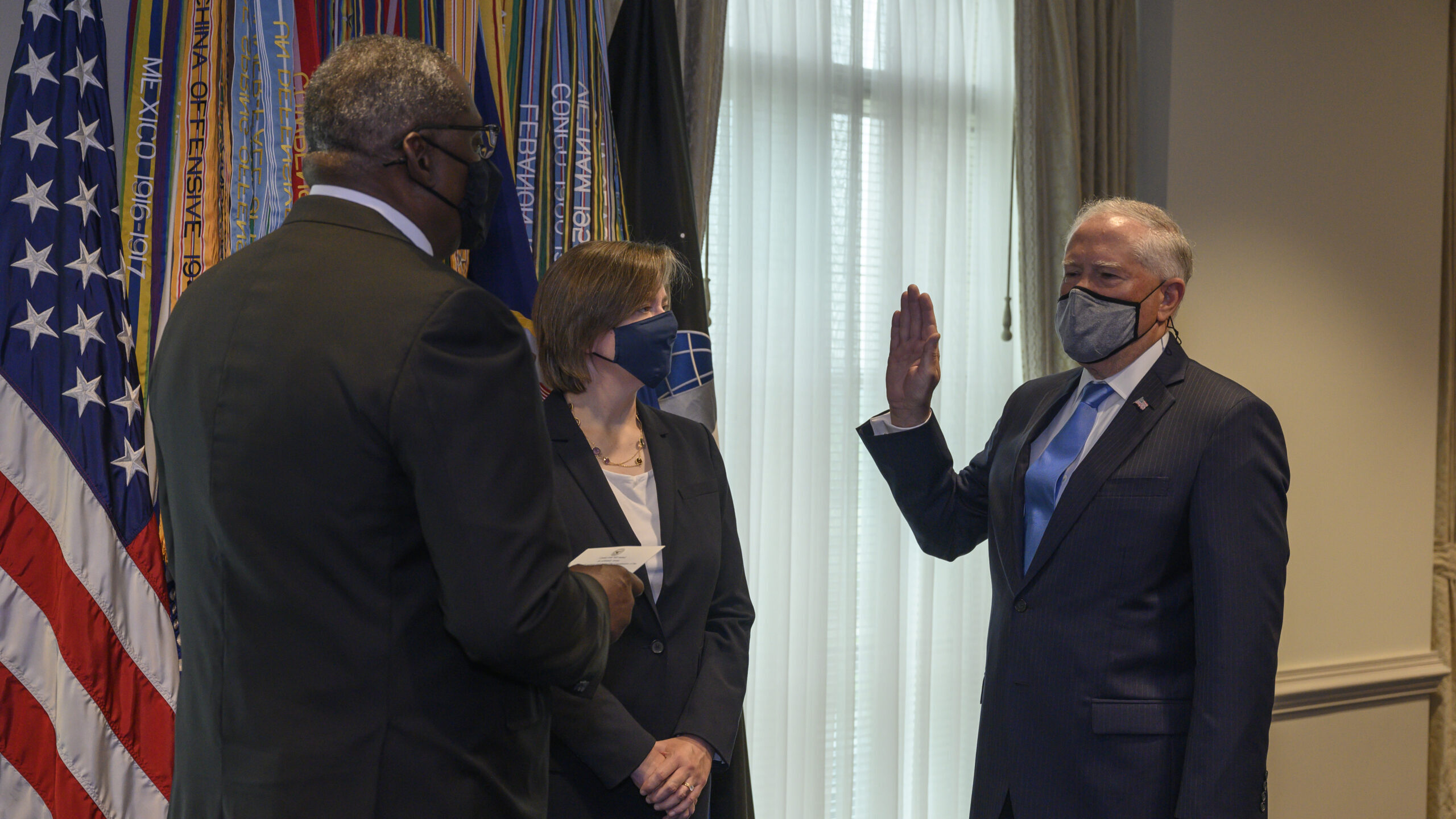
Air Force Secretary Frank Kendall was sworn in at the end of the summer. (US Air Force/Staff Sgt. Brittany A. Chase)
WASHINGTON: If you’re in the military, you’ve probably heard the saying “Hurry up and wait.” It applies to doing things inside the Defense Department, and sadly, it also applies to covering the Pentagon and military services.
In 2021, the Air Force put a lot of balls in motion — we saw new leaders come into office and heard hints about some exciting new aircraft programs. But a lot of the major decisions won’t be finalized until next year. I’ll be waiting to see if the Air Force can juggle all its plans with the flat budget undoubtedly coming down the line in fiscal 2023, but here’s a refresher on the biggest news stories in 2021:
[This article is one of many in a series in which Breaking Defense reporters look back on the most significant (and entertaining) news stories of 2021 and look forward to what 2022 may hold.]
Frank Kendall Brought New Direction To Top Job
In April, the Biden administration announced its nomination of Frank Kendall to become the new secretary of the Air Force. Kendall, a former Pentagon acquisition head with the knowledge to dive deep into the bureaucratic weeds of the department, made it clear his goal was to field tech to counter the rising threat of China.
Immediately after taking office in August, Kendall started shaking things up, first by ordering a review of the service’s FY23 budget plans to ensure it was structured with the goal of deterring China. He also refocused the service’s Advanced Battle Management System program, scoping it to prioritize fielding capability instead of emphasizing open-ended exercises.
Then, in September, he seemed to imply that China was potentially working on a Fractional Orbital Bombardment System capable of presenting a global strike from space. Weeks later, reports confirmed that China had tested a hypersonic FOBS this past summer.
Now the question facing Kendall is, can he make good on his talk and transform the Air Force, or will pressures from Congress, the Defense Department and the service itself force the service to pursue less dramatic change?
Study On Tactical Aircraft Challenged Prevailing Ideas
The F-35 was developed to replace a long list of aircraft — chief among them the Air Force’s multirole F-16 fighters, which number more than a thousand planes. But in February, Air Force Chief of Staff Gen. CQ Brown acknowledged that the service is exploring other options.
A tactical aircraft study carried out this year would help formulate FY23 budget plans and solidify the Air Force’s make up of its future fighter fleet, Brown said then. Most notably, Brown mentioned the service was considering a low-cost, clean-sheet “fourth-gen plus” fighter to replace a portion of the F-16 fleet. It was an admission that the service’s long professed program of record of 1,763 F-35As may be cut in the coming years.
The service has said little about the study since Kendall has come into office, leaving its ultimate impact or outcome unknown. Perhaps the FY23 will give a glimpse of whether a major overhaul of the Air Force’s fighter programs is to come.
Congress Got Tough On The F-35
As the Air Force internally debated how many F-35s it needs, lawmakers made clear that they are exasperated with the cost of operating and maintaining the F-35. House Armed Services Committee chairman Rep. Adam Smith called the program a “rathole.”
Of particular concern was an ongoing shortage of the jet’s Pratt & Whitney F135 engine, which some lawmakers said was the reason to potentially seek out a new engine supplier. All of this coalesced in a FY22 defense policy bill that imposes cost constraints on the program, potentially limiting the number of F-35s the Air Force, Navy and Marine Corps can buy and operate in the late 2020s.
Proposed E-7A Wedgetail Buy Gained Momentum
Air Force officials have long whispered about the possibility of buying the E-7A Wedgetail airborne early warning plane to replace its aging E-3 AWACS fleet, but the idea seems to be gaining traction.
Mike Manazir, Boeing’s vice president for defense business development, said he’s “very confident” the Air Force would buy the plane, telling reporters at the Dubai Airshow in November to expect an announcement from the service in 2022.
In other words, when the FY23 budget comes out next year, check to see whether the Wedgetail has gotten its first procurement dollars.
Congress Actually Allowed The Air Force To Retire Aircraft
For the past several years, the Air Force has tried to free up funding by retiring some of its oldest and most difficult to maintain aircraft, and its FY2022 budget request was no exception. In it, the service proposed retiring more than 200 aircraft, including: 42 A-10 Warthogs, 47 F-16C/Ds, 48 F-15C/Ds, 14 KC-10s, 18 KC-135s, 13 C-130Hs, four E-8 JSTARS aircraft and 20 RQ-4 Global Hawk Block 30 surveillance drones.
Typically, Congress only allows a fraction of the Air Force’s proposed divestitures to actually be retired. However, the FY22 National Defense Authorization Act breaks with tradition by allowing the service to mothball all the aircraft it requested, with one exception: the A-10 Warthog. This could mean that the Air Force is making inroads with lawmakers, having adequately conveyed the importance of taking some near-term risk to help fund game changing technologies to be fielded down the road.






















